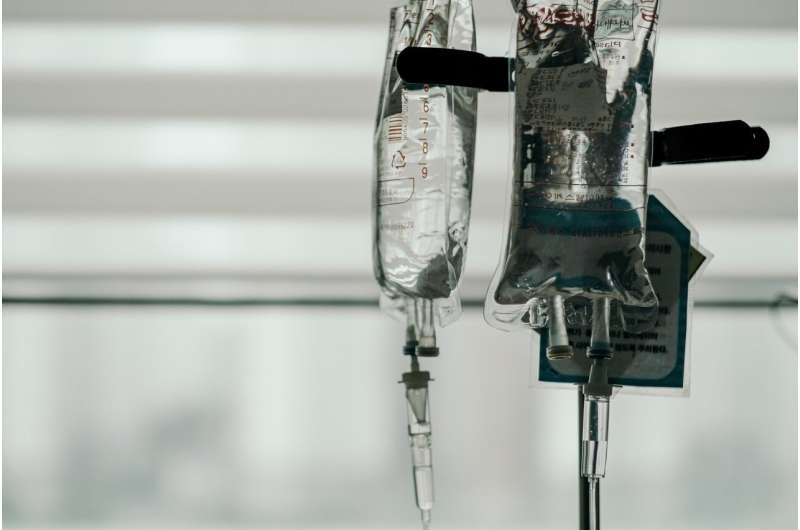This article has been reviewed according to Science X's editorial process and policies. Editors have highlighted the following attributes while ensuring the content's credibility:
fact-checked
trusted source
proofread
Prescription drug shortages reach all-time high, forcing tough treatment decisions

Doctors and hospitals across the country are scrambling to make every drop of chemotherapy and other prescription drugs count, given the national shortage in medicines used to treat cancer and a multitude of conditions.
With prescription drug shortages happening in the United States on and off for the last decade, deficits are at an all-time high—a reality that makes treatment decisions difficult for doctors and affects patients in need of critical drugs like chemotherapy and antibiotics, Johns Hopkins experts said Friday, June 2, during a virtual discussion as part of the Johns Hopkins Congressional Briefing series.
"Chemotherapy drugs are among the most important tools or weapons we have as oncologists to help our patients—they help save and extend lives," said Amanda Fader, a professor of gynecology and obstetrics at Johns Hopkins Medicine. Yet "many life-saving drugs that we use to treat both adults and children [with cancer] are the drugs in the most critical shortage at this time."
Right now, hospitals nationwide face a shortage of 15 commonly prescribed chemotherapy drugs used to treat several cancers, from gynecological cancers like ovarian, uterine, and cervical cancer to testicular, lung, breast, prostate, head, neck, and esophageal cancer, according to Fader. Drugs in the most severe shortage are the platinum-based drugs, such as cisplatin and carboplatin, which often serve as curative treatments for many cancer patients.
Tinglong Dai, a professor of operations management and business analytics at the Johns Hopkins Carey Business School, attributes the current drug shortage to problems with the supply chain, especially the lack of quality controls in the drug manufacturing process. "This is a crisis not of quantity but of quality," Dai said. For example, at a factory in India that manufactured chemotherapy drugs, the United States Food and Drug Administration uncovered a "cascade of failures," ranging from inadequate documentation to insufficient steps taken to prevent microbiological contamination, according to Dai.
But the situation in India, which led to the shutdown of the factory, is not uncommon, happening not only overseas but also in the U.S. The real problem, Dai explained, is the FDA's inability to inspect the thousands of companies—many on the other side of the world—currently manufacturing prescription drugs. "In 2022, the FDA inspected only 6% of the nearly 3,000 foreign facilities, and most of the generic drugs Americans consume or will be using [come] from those facilities," he said.
Mariana Socal, an associate scientist at the Johns Hopkins Bloomberg School of Public Health, said she believes that in addition to broadening the country's inspection capabilities, we need to prepare for emergency situations like spikes in demand, which will inevitably happen. One way to do that is to diversify the manufacturing of drug ingredients, which takes place at only a few facilities worldwide. When one facility runs into trouble, whether due to deficient quality controls or something else, that can disrupt the whole supply chain.
Currently, "we have only three drug wholesalers in the country that really … concentrate all the drug transactions, in terms of drug inventory," Socal said. "Only these wholesalers know who they're selling to and where their inventory is located geographically in the United States," and that needs to change. The process starts with better understanding and recognizing where drugs are located, who is producing them, and who is producing the active ingredients that go into them, she said.
Joshua Sharfstein, who worked previously as the principal deputy commissioner at the FDA and now serves as a professor of the practice at the Bloomberg School, believes the FDA and other government agencies are not set up to oversee and resolve prescription drug shortages. "Our system is not designed to address drug shortages in the usual manner of business," Sharfstein said. "It's a gap."
"What we need is a real strategy and an empowered agency working with other agencies," advised Sharfstein, who serves as vice dean for public health practice and community engagement. The U.S. needs to collaborate with regulatory agencies from other countries, with the FDA "shar[ing] information about our inspections with others and get[ting] information about their inspections, and work[ing] so that plants are routinely inspected, not necessarily every time by someone taking a plane from the United States or from one of the FDA outposts but potentially from a trusted partner," Sharfstein said.
Creating stockpiles of critical drugs can help, too. But right now, no agency in the U.S. has the power to do that. "We just don't have the structure to deal with a problem this complex," he said.





















